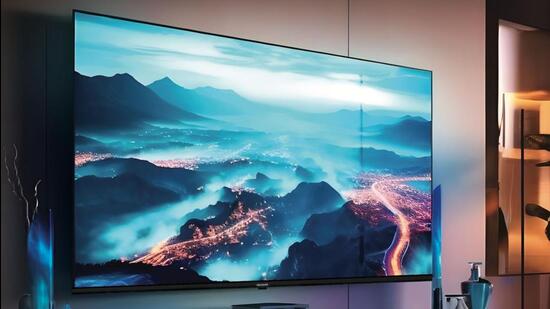This is a brand that evokes childhood memories. It was the late 1990s when a host of tech companies abroad made a beeline for India. Two names that still stood out were Aiwa and Akai, which promised Japanese (then famed for precision and reliability) quality and performance, but not at the sort of price tag premium brands such as Sony demanded. Is history repeating itself?

We pose this question, as Aiwa is making another pitch with smart TVs. The company’s latest QLED Google TV, in 65 inches, has many brands on its radar. Sony, Samsung, OnePlus, Xiaomi and TCL, to name a few. This, with a price tag of ₹1,49,900 before possible discounts (we’ve seen market price as low as ₹70,000), is undercutting some rivals (a few, quite significantly) while well placed in shop floor competition with the rest. Our experience with this TV (the specific model number is Aiwa A65QUHDX3 GTV), testifies to definite strong points in its arsenal.
There’s very little left to chance with the spec sheet. The 65-inch QLED, or Quantum dot LED TV panel, has a native 3840 x 2160 resolution. That’s supported along with support for Dolby Vision and HDR10 standards for high dynamic range (HDR) content you’ll encounter on Netflix, Amazon Prime Video, Disney+ Hotstar or even if you have a Tata Play Binge set-top box. From the off, with HD or Ultra HD content, the Aiwa QLED Google TV 65 begins to show its prowess.
Not so much with standard definition content despite the expected image upscaling tech that’s always at work in large screen TVs. Anything less than full HD content does look too soft, and unless you have a source such as a Tata Play Binge STB that does its own upscaling too, edge noise is quite visible around certain elements – such as a cricket score card. The only real option is to dial down the sharpness level (noise reduction settings are more aggressive, leading to an even more softer than usual picture).
Google TV references its smart TV underlier, which should work well enough for most users. Needless to say, all popular streaming platforms we use regularly, install and work seamlessly. A regular annoyance with Google’s implementation of Google TV is the ‘For You’ tab, which gives you little control over recommendations, sorting and priorities. Often, the interface simply struggles for a few minutes, because the recommendations are refreshing. Do they really need to, so often? The trick here is, to turn Google TV to “apps only” if you really want a slick, uncomplicated and fast Google TV interface to work with.
The optimisation of the vertical LED array is as it should be – you’ll not see uneven lighting infiltrating darker scenes in a movie, and this screen can go perfectly dark in regions, when needed. The other side of the coin is, this is a really bright screen when you need it to be at its vivid best. That’s not easily managed, without compromising colour separation and richness, something the Aiwa QLED Google TV 65 manages surprisingly well (backlight at level 70, is a good way to gauge). That said, whites can often come across as too pure, and a bit discomforting.
At most common home viewing picture settings (with illumination somewhat dialled down), this is indeed one of the most comfortable screens to look at. There perhaps is still some tweaking needed to get this to the sort of colour tone that OnePlus’ QLED TVs managed, but it is something that can be sorted with software updates down the line. It is very manageable for now, but the panel quality leads us to believe, there’s more that can be drawn in terms of picture quality optimisation. In particular, with how it handles fast moving visuals – Formula 1 race broadcasts streamed Live in Full HD, or a game console connected.
Aiwa has definitely done well with the sound. It does not mean you’ll probably not reach out for a dedicated soundbar or a home theatre, but there’s still some flexibility to be had, if you don’t immediately have the money to spend. Don’t expect too much bass from the TV’s speakers, but clarity of sound and vocals in particular, is good. Tweak the equaliser to moderate sharpness of higher frequencies, and enable the dialogue enhancer as needed, and it’s good enough for viewing (and listening), in a large hall space.
I am left with a feeling that Aiwa could have done a bit more with the design.
The way it is, particularly with the table-top installation, the Aiwa QLED Google TV 65 doesn’t have the sort of premium visual appeal that’ll get your friends talking about it. Dual stand design (installing close to either end of the panel) means you’ll need a table as wide as this TV. A bit more inspiration from how Sony and OnePlus refreshed the table stand approach, could have helped. Right now, it is akin to a ₹30,000 smart TV, and that’s not a good look for a premium TV.
Even though there are a few expected compromises such as a middling design and a remote that’s straight out of the budget smart TV playbook, there’s nothing that really takes away from the fact that the Aiwa QLED Google TV 65 is a genuinely good smart TV, particularly when you consider the display real estate you get in return for the money you’re spending. This will shine with High Definition and higher quality content streams, and really, that’s what you’d buy a 65-inch TV for.